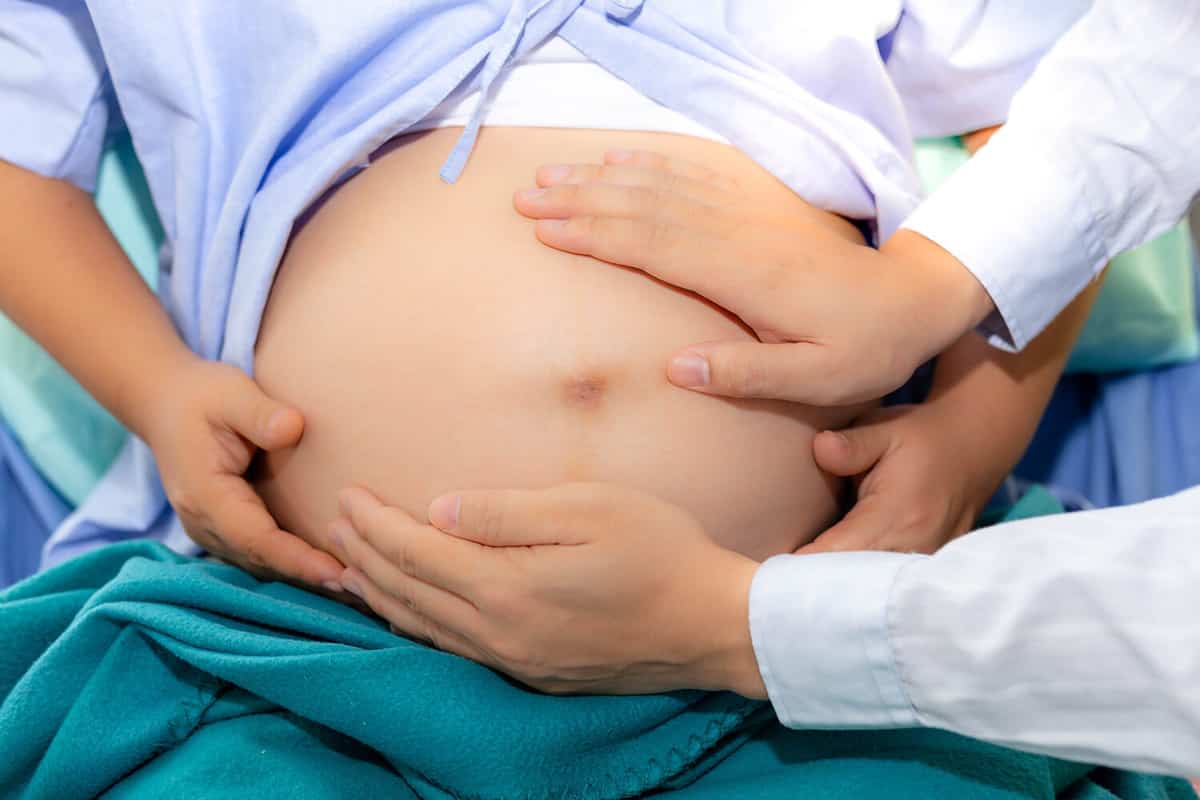

When Should Babies Be Head-Down During Pregnancy?
During pregnancy, it’s normal to wonder if your baby is preparing for birth just like you are. While complications can happen for some women during pregnancy, there are also many ways your baby prepares for birth without any intervention. One of the ways your baby prepares is getting into a head-down position. This position allows for the smoothest birth, but you might wonder when you should expect your baby to be in the head-down position.
While not every baby gets into the head-down position at the same time, most babies will turn between 32 and 36 weeks. If your baby isn’t head down by this point, there’s no need to panic. There’s still time for your baby to change positions before you go into labor.
If you’re currently pregnant, it can be helpful to know what to expect as you prepare for the birth of your little one. Keep reading to find out more about when your baby should be head down during pregnancy.

When Should a Baby Be Head Down During Pregnancy?
Toward the end of your pregnancy, you’ll start to notice some signs that your body and baby are preparing for birth. This might look like more frequent Braxton-Hicks contractions or shortness of breath as your baby grows. You also might notice that your baby is trying to get in the right position for birth.
Even though you might not know when your baby turns to get in the head-down position, you can usually tell after they’ve moved. If your baby is head down, you’ll start to feel your baby’s kicks towards the top of your belly or underneath your ribs.
For most women, their baby gets in the head-down position between 32 and 36 weeks. Babies in utero tend to move around and change positions frequently but by 36 weeks, your baby should stay put in the head-down position. The bigger they grow, the harder it is for them to move around in your womb.
Even if your baby isn’t head-down by 36 weeks, there’s no need to panic. Some babies turn even later in pregnancy while others wait until you’re in labor to move! Let’s take a closer week at why it matters if your baby is head-down or not.
Why Does Baby Need to Be Head Down?
Just like you’re preparing for birth during the third trimester, your baby is preparing as well. One of the ways your baby gets ready is by getting into the proper birth position. Your baby’s position matters because it can significantly impact how labor goes.
If your baby isn’t in the head-down position yet, it doesn’t necessarily mean you’ll have any complications, but the head-down position allows for the smoothest delivery in most cases.
It’s important to know there is more than one variation of the head-down position since your baby can be facing several different directions. There’s also the possibility that your baby doesn’t turn and stays in a breech position or even a side-lying position.
When it comes to pregnancy and birth, there are many variations of normal, so just because your baby isn’t head-down doesn’t necessarily mean there’s something wrong. For many women, it can be scary to hear your baby is breech, however, breech births can go smoothly as well with the right provider. Either way, it’s good to know what to expect and know when there is a cause for concern.
Different Head-Down Positions
Head-down is a great start when it comes to identifying where your baby needs to be to prepare for birth, but there is more than one head-down position. If your baby is head down by 32 weeks, it could be in an occiput anterior position, occiput posterior position, or occiput transverse position.
Additionally, each of these positions has a variation for what side your baby is facing. For example, your baby could be in a right occiput anterior position if they’re slightly facing the right side of your pelvis or left occiput anterior if they’re slightly facing the left side.
Occiput Anterior
The occiput anterior position means your baby is head-down and facing toward your back. This is considered the ideal position for birth and allows for the smoothest delivery. In this position, your baby is ready to make their way through the birth canal.
The left occiput anterior position, where your baby is slightly facing your left side is the most common variation. However, both variations of the occiput anterior position lead to fewer complications than other positions.
Occiput Posterior
The occiput posterior position is a variation of normal but is considered a more challenging position for your baby to be in. It’s sometimes known as the “sunny-side-up” position because your baby is head down but they’re facing your front instead of your back.
While there may be no complications that come with this position, pregnant women tend to experience more back labor when their baby is facing this way. Both the right occiput posterior and left occiput posterior position can lead to more pain. However, it’s not uncommon for babies in this position to turn to the occiput anterior position during labor.
Occiput Transverse
Another variation of the head-down position is the occiput transverse position. This position means your baby is head-down, but they’re completely facing either your left or right side. In this case, they’re halfway between a posterior and anterior position.
Like the occiput posterior position, the transverse position can lead to more pain during labor. However, if your baby was originally in a posterior position but moved to the transverse position, this can be a sign that they’re moving toward the anterior position.

©Nutlegal Photographer/Shutterstock.com
How Do You Know When Baby Is Head Down?
Now that you’re aware of when and why your baby should be head-down, your next question might be how do you know what position the baby is in? It’s not always easy to identify a baby’s position yourself, but there are some ways you can tell.
One way that many women determine their baby’s position during pregnancy is called belly mapping. Belly mapping involves using your baby’s movements to predict their position.
There are some factors, such as the position of the placenta or the amount of amniotic fluid, that can make it difficult for you to determine your baby’s position. However, you can get a pretty good idea based on what types of movement you feel in certain areas. For example, if you feel strong, intense kicks on one side of your belly, you know that’s where the baby’s feet are located.
Feeling strong kicks consistently toward the top of your belly instead of the bottom is a pretty good indication that your baby is head down. If you’re concerned about feeling around your belly yourself, your midwife or doctor can help you identify your baby’s position, even without an ultrasound.
Ways to Help Baby Get in the Right Position
As you wait for your little one to get into the head-down position, it can be concerning if you’re past 32 weeks and they still haven’t moved. Not every baby follows the same timeline during pregnancy and it may require some patience on your part if your little one doesn’t turn head-down right away.
Although many babies move on their own before labor starts or even during labor, there are some ways to help babies get in the right position. Here are some tips your provider might suggest for helping baby get in the right position:
- Keep moving
Movement is one of the best ways to ensure your baby is preparing for labor and for you to prepare for labor too. Taking frequent breaks from sitting and getting the right amount of exercise can help your baby get in the right position. - Use a birth ball
Birth balls are a great way to prepare for labor. You can bounce on the birth ball or do hip circles throughout the day to prepare and encourage your baby to move if they’re not head-down yet. - Keep your pelvis tilted forward
Proper posture is essential during pregnancy and you can help baby prepare by keeping your pelvis tilted forward when you’re sitting. If it helps, use a cushion on your seat or in the car. Keeping your pelvis tilted forward prevents you from arching your back and makes it easier for your baby to move to the head-down position.
When Should You Be Concerned?
If most babies turn to the head-down position by 36 weeks, what do you do if your baby isn’t head-down yet? By this stage in your pregnancy, your provider has likely identified what position your baby is in. What this means for your labor and delivery will depend on your provider and where you’re giving birth.
Your baby being in a different position, like a breech position where your baby is feet down instead of head down, can be scary. Even though some doctors are not trained in delivering breech babies, a vaginal birth is still a safe option for some moms.
Even if your baby doesn’t turn head-down during the third trimester before you go into labor, one study showed that over 50% of women were considered eligible for a vaginal delivery despite their baby being in the breech position.
Despite breech being a possibility for any pregnancy, it’s relatively uncommon overall. One statistic shows that only 3-4% of babies are in a breech position at full-term. Although the majority of breech babies are born via planned cesarean section, there are ways for trained providers to help turn breech babies to improve the outcomes for mothers and babies and avoid a c-section.
Head-Down Position During Pregnancy: Final Thoughts
Like any part of your pregnancy and birth, you’ll want to know what to expect so you can have peace of mind. When it comes to your baby getting into a head-down position, this happens for most babies between 32 and 36 weeks. However, some babies move into the proper position later. Some babies even wait until labor begins to turn.
Every position can be a variation of normal and still lead to an uncomplicated delivery with the right provider. By the middle of your third trimester, you can tell what position your baby is in or ask your provider for assistance so you know if your baby is ready for birth.